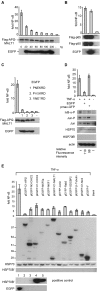The dark side of EGFP: defective polyubiquitination
- PMID: 17183684
- PMCID: PMC1762387
- DOI: 10.1371/journal.pone.0000054
The dark side of EGFP: defective polyubiquitination
Abstract
Enhanced Green Fluorescent Protein (EGFP) is the most commonly used live cell reporter despite a number of conflicting reports that it can affect cell physiology. Thus far, the precise mechanism of GFP-associated defects remained unclear. Here we demonstrate that EGFP and EGFP fusion proteins inhibit polyubiquitination, a posttranslational modification that controls a wide variety of cellular processes, like activation of kinase signalling or protein degradation by the proteasome. As a consequence, the NF-kappaB and JNK signalling pathways are less responsive to activation, and the stability of the p53 tumour suppressor is enhanced in cell lines and in vivo. In view of the emerging role of polyubiquitination in the regulation of numerous cellular processes, the use of EGFP as a live cell reporter should be carefully considered.
Conflict of interest statement
Figures



References
-
- Liu HS, Jan MS, Chou CK, Chen PH, Ke NJ. Is green fluorescent protein toxic to the living cells? Biochem Biophys Res Commun. 1999;260:712–717. - PubMed
-
- Zhang F, Hackett NR, Lam G, Cheng J, Pergolizzi R, et al. Green fluorescent protein selectively induces HSP70-mediated up-regulation of COX-2 expression in endothelial cells. Blood. 2003;102:2115–2121. - PubMed
-
- Agbulut O, Coirault C, Niederlander N, Huet A, Vicart P, et al. GFP expression in muscle cells impairs actin-myosin interactions: implications for cell therapy. Nat Methods. 2006;3:331. - PubMed
-
- Huang WY, Aramburu J, Douglas PS, Izumo S. Transgenic expression of green fluorescence protein can cause dilated cardiomyopathy. Nat Med. 2000;6:482–483. - PubMed
-
- Krestel HE, Mihaljevic AL, Hoffman DA, Schneider A. Neuronal co-expression of EGFP and beta-galactosidase in mice causes neuropathology and premature death. Neurobiol Dis. 2004;17:310–318. - PubMed
Publication types
MeSH terms
Substances
LinkOut - more resources
Full Text Sources
Other Literature Sources
Research Materials
Miscellaneous

